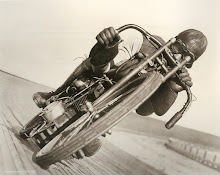



Report 4th Oct
Early morning and Basil K. and myself travelled the short distance across town to 'Crackleport Towers' the family ancestrol home. Underneath this stately pile runs a labarinth of passages and within these are stored many historic machines and motoring artifacts.
Our search was concentrated underneath the 'West Wing' , the 20ft long x 3ft high passage leads to a chamber and there stored for many years I expected to find our quest. I was looking for a vintage sidevalve of immense proportions. The small J.A.P and larger Villiers singles that blocked my path were of no consequence today.
In the furthest corner underneath years of dust and cobwebs I saw it.....rusty yes, but I've seen worse.....a Briggs and Stratton. The water slide transfer on the cowl proudly proclaiming it's roots.
Made in Wilwaukee U.S.A.
Basil K. held the hand lamp as I dragged our prize slowly and carefully back down the dark passage towards the staircase and fresh air....
Not wanting to be left out in this historic moment Basil K. took over the manual lift up the narrow twisty staircase and in no time the ancient motor was free of it's tomb where it had laid undesturbed for over 20 years.
A celebratory cuppa and 'jammie dodger' biscuit were timely provided by mum, as we stood in awe looking at this internal combustion masterpiece.
"Are ya taking some more rubbish away young Albert?" asked mum.....
"Yeah," I replied, not wanting it be known that this was a valuable family heirloom...
Into the boot of Basil K.s transporter and back across town to 'The Old Sidevalve Bar' for further analysis....




























